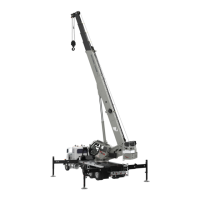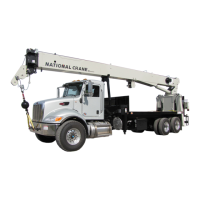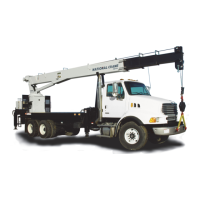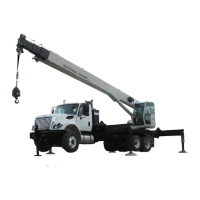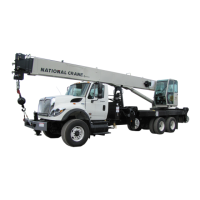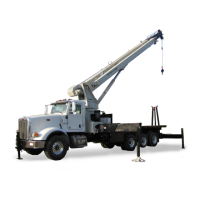CONTROLS AND OPERATING PROCEDURES OPERATOR MANUAL NTC55
3-22 Published 9-26-2018 Control # 646-02
vertical load line or block. This distance is slightly
greater with an unloaded boom due to deflection.
• Loaded Boom Angle - The loaded boom angle is the
angle between the first section boom and the horizontal
with the load. The loaded boom angle combined with the
boom length approximates the operating radius.
• Working Area - The area measured in a circular arc
above the center line of rotation to the suspended load.
• Freely Suspended Load - The load hanging free with
no direct external force applied except by the loadline.
• Side Load - Horizontal side force applied to the lifted
load either on the ground or in the air.
• Boom Length - The length from boom pivot pin to the
boom nose. Decals on either side of the boom shows
when specific boom lengths are reached.
• Range Diagram - The range diagram (Figure 3-13)
shows the operating radius and height of the unloaded
boom nose at all boom lengths and angles. It should be
used as a guide to position unloaded load line and to
determine to approximate height to which the load can
be lifted.
• Structural Limit Line - Is contained in the range
diagram (Figure 3-13). It shows the lowest angle the
unloaded boom can be placed at for all boom lengths.
Below this line the machine is structurally overloaded.
The load chart contains the lifting capacities of the crane in
all allowable lifting configurations. The information is
presented in several parts, which include four different
outrigger spans (fully retracted, mid-span, partial and fully
extended), one outrigger span when lifting “over-rear”, and
two counterweight configurations for the NTC55 and three
counterweight configurations for the NTC55. Each part
contains the load chart, range diagram, and hoist data sheet.
In the examples shown here, the information for the
outriggers fully extended is used.
NOTE: The load charts shown in this manual are examples
only. See the load charts attached to the crane for
actual values.
• The load chart (Figure 3-16) is used to determine the
weight limit of the load based on the load radius and
boom angle. All lifting devices must be included when
determining the weight of the load.
• The range diagram (Figure 3-13) shows the operating
radius and the height from horizontal of the unloaded
boom.
• The hoist data chart (Figure 3-14) shows hoist capacity
and multi-part line reeving. The correct reeving for all
loads listed in the load chart is also shown.
Before you can determine the crane configuration you need
to know:
• the weight of the load to be lifted.
• the lifting devices needed.
• the height of the lift.
• the horizontal distance from the center of rotation (load
radius) to where the load is to be placed.
To determine the safe operating parameters you need to:
1. Get the weight of the load to be lifted.
2. Approximate the load radius. This is the horizontal
distance from crane center of rotation to where the
payload is to be placed.
3. Determine the lifting devices and hook block reeving
using the hoist data chart.
4. Calculate the combined weight of the lifting devices and
the load to be lifted.
5. Determine the boom angle and length from the range
diagram using the height and load radius of the lift.
6. In the load chart, take the load radius and boom angle/
length column over to the weight column and check the
weight. If the weight is between two values, use the
lower value.
LIFTING THE LOAD
The following general guidelines outline the proper
procedure for making a lift after the crane has been properly
set up.
1. Position the crane in the work area and set the
outriggers. See Outrigger Setup, page 4-1.
2. Program the RCL. Use the load chart to estimate the
values.
3. Position the boom nose over the load. Do not try and
drag the load with the boom or hoist.
4. Perform the lift. Use light variable movements of the
controls when moving the load to avoid sudden stops.
5. Retract and lower the boom after the lift is complete.
SHUT DOWN AND PREPARATION FOR
ROAD TRAVEL
CAUTION
Disengage the hydraulic pumps for extended traveling,
cold weather starting, or engine checks.
Check cold tire pressure prior to extended travel. Refer to
tire inflation decal on crane.
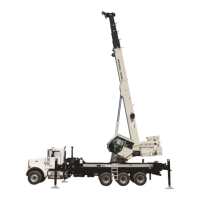
